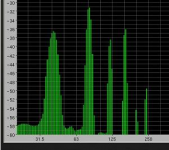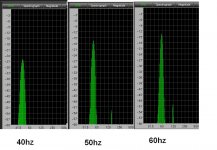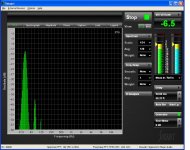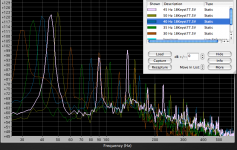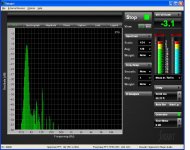The BC18SW125-4 loaded Keystone Subs will take a lot more power, they were not getting warm with 77.5 volts of sine wave.
Search for the point where excursion is minimum, impedance is low and SPL output high. Try your 77.5V clean sine-wave signal test at that point for >20min… (with intervals)a single tone allows me to measure excursion at the test frequency
Last edited:
No, thanks, not into dubstep :^).Search for the point where excursion and impedance is low and SPL output high. Try your 77.5V clean sine-wave signal test at that point for >20min…
Did you see Jim's SS15 over 100% distortion at 40 Hz screen shot yet ?
The first harmonic would read about six dB more than the fundamental on a dB meter !
Attachments
No, thanks, not into dubstep :^).
Did you see Jim's SS15 over 100% distortion at 40 Hz screen shot yet ?
The first harmonic would read about six dB more than the fundamental on a dB meter !
Wow, that's...terrible.
What software is being used in that screenshot?
Smaart.Wow, that's...terrible.
What software is being used in that screenshot?
Jim (jBell) has not posted the drive level used on the SS15 in the screenshot, but distortion in well in excess of 100% is common for boxes driven below Fb or Fc .
I am curious as to the distortion in the passband.
Art
Lol, not just dubstep Art, many modern music styles have strong signals around that area these days.No, thanks, not into dubstep :^).
Did you see Jim's SS15 over 100% distortion at 40 Hz screen shot yet ?
The first harmonic would read about six dB more than the fundamental on a dB meter !
I have seen Jbells chart a while ago. Actually, I also asked the same question, if he could show other sine waves within the bandpass....
...Trust me I know this data backwards and inside out. You have rightfully assumed that many of these "Hifi" vented and sealed cabs are going to be in the 90db at 1w sensitivity range with some probably even lower near to 85-88db. I can actually tell you what the efficiency and sensitivity on some of the DIY subs tested there are because I own the same drivers in very similar cabs. These numbers would be at 1 meter. At 2 meters the sub will need an additional 6db of input power to reach that same 90db at the microphone. That puts the drive level at 4 watts not 1w. When you pile on 20db more level into the subwoofer to reach a nominally 110db sweep level, from the base of a 4w input to produce 90db nominal, you are at a 400w power level already not 100w. The 100w sweep level would be more likely to be the 105db one...
I tend to agree with you, and the whole point is these charts show trends. This is what I expect to see from a subwoofer measurement. Whether 105dB is 100 watts depends on the driver, obviously, but it does fit the picture just fine. We can move the line up or down 6dB and still be in the ballpark.
If you do the prosound shootout I will be there. I could bring any of 3 tapped horns or a BR. I also have a pair of Powersoft K10's if you need some power.
Very good, should be a lot of fun and I look forward to seeing you there. I'll try and find a date in October when the track has a weekday opening and let you know. We usually do weekdays, because people most often do gigs on the weekends and need to be back. Besides, even in October, the track is still in use for racing on the weekends. October is nice because it has cooled a little bit, generally around ~70° in the afternoon.
Why are you guys trying to use an RTA to capture the THD of a sine wave at a single frequency still? 😕
Exactly. That's the point. We'll use LMS at the Prosound Shootout, and stick to the same test plan as previous years. That way the data will be consistent between all systems, even those measured in 2005 and 2007.
There was one year (2006) we used Praxis, and while it is a good system, we did not achieve the same consistency with it. We did not set drive power constant, but rather drive voltage, which made SPL comparison confusing. We also did not test distortion.
I agree with you, with a HP the output below Fb or Fc is academic.
The only reason I “harped” on the 30 Hz distortion was my data shows the WS Lab 2x12 to have MORE distortion in the passband, and LESS below than the 12Pi, which bears out your “horns have less distortion” statements, but opposes your observation that push pull has the most effect below Fc or Fb.
I gotta calls ‘em likes I sees ‘em.
But with the measurements you have made, I don't think you "gotta call 'em" at all.
I tried to be polite, at least at first, even though you had been dismissing my cooling plugs and horn design for months prior to my noticing the 12Pi thread. I could see your measurements were irregular, but tried to throw a bone and say maybe it was the missing harmonics that did it. But what I think is actually responsible is you have been using the Smaart RTA to measure distortion, and that is probably not the right tool for the job. It looks to me like it can't be compared with measurements from LMS, which I trust. In my opinion, you might as well have been using a Radio Shack meter and a test tone.
If you hadn't been so disparaging and persistent, maybe I wouldn't come across this way. I realize you were using what you had. But I think you were unfair, to say the least. Now all I have to say to you is pack it up and bring it. No point talking about it - let's line 'em up.
Wayne,We'll use LMS at the Prosound Shootout, and stick to the same test plan as previous years. That way the data will be consistent between all systems, even those measured in 2005 and 2007.
But with the measurements you have made, I don't think you "gotta call 'em" at all.
I tried to be polite, at least at first, even though you had been dismissing my cooling plugs and horn design for months prior to my noticing the 12Pi thread. I could see your measurements were irregular, but tried to throw a bone and say maybe it was the missing harmonics that did it. But what I think is actually responsible is you have been using the Smaart RTA to measure distortion, and that is probably not the right tool for the job. It looks to me like it can't be compared with measurements from LMS, which I trust. In my opinion, you might as well have been using a Radio Shack meter and a test tone.
If you hadn't been so disparaging and persistent, maybe I wouldn't come across this way. I realize you were using what you had. But I think you were unfair, to say the least. Now all I have to say to you is pack it up and bring it. No point talking about it - let's line 'em up.
Calling my results bogus is trying to be polite in your mind 🙄?
You run a single 40 Hz tone through a Lab 12 and burn it up, add a cooling plug and it does not.
As if a single frequency, turned on and off, emulates real world music content LOL.
Did the cooling plug also reduce power compression by 3dB, or simply allow a short term LMS sine sweep to be survivable?
Now you suggest that the results of a single sine wave on a Smaart will not show distortion ?
How can there be "missing harmonics" in the Smaart RTA display?
If you ever bothered to try the single tone RTA method, you will find it shows what your precious LMS system does in more detail, and will agree closely in distortion percentages.
Granted, I wouldn't use the method if I had LMS or something else that measured distortion quickly, but you have yet to point out anything that shows the method I used is flawed by more than 1/2 a percent.
In most subs, 1/2% is fractional to the distortion percentage at anywhere close to full power.
But as we both know, around 10% distortion in a sub is not very easily detected by ear, even with single sine wave tones.
Art
Now all I have to say to you is pack it up and bring it. No point talking about it - let's line 'em up.

Lol, not just dubstep Art, many modern music styles have strong signals around that area these days.
I have seen Jbells chart a while ago. Actually, I also asked the same question, if he could show other sine waves within the bandpass....
Now, I realize I'm just a sideshow to this thread at the moment... but I didn't want anyone to think that the ss15 was just a distortion monster... so here is the 40,50,60hz sine waves at a reasonable 12volts.
What I posted with all of the harmonics was well past reasonable, into destroy the driver territory. Scott has made several references that Tapped Horns 'bloom' and reflex boxes 'wilt' at war volume. I have also made several attempts at trying to find out just why this box sounds so darn flat at war volume, when it shouldn't.... It was the even order harmonics that surprised me... I was not expecting that, considering it is a quarter wave box. However I should have figured it out, 40hz is below horn tuning, and so the harmonics were just the driver trying to tell me to turn it down.....
Attachments
Hey Jim,Now, I realize I'm just a sideshow to this thread at the moment... but I didn't want anyone to think that the ss15 was just a distortion monster... so here is the 40,50,60hz sine waves at a reasonable 12volts.
What I posted with all of the harmonics was well past reasonable, into destroy the driver territory. Scott has made several references that Tapped Horns 'bloom' and reflex boxes 'wilt' at war volume. I have also made several attempts at trying to find out just why this box sounds so darn flat at war volume, when it shouldn't.... It was the even order harmonics that surprised me... I was not expecting that, considering it is a quarter wave box. However I should have figured it out, 40hz is below horn tuning, and so the harmonics were just the driver trying to tell me to turn it down.....
"A reasonable 12 volts" (a whopping 18 watts, real "war" volume), what happened to the 46+ volts as used in the sims?
Come on, man up, I test all my speakers at their rated RMS value into the nominal impedance and post the results for all to see, and Wayne P. to call bogus 😀.
If Scott means by "bloom" that his cabinets distort more than ported speakers, he's probably correct, all the drivers I have tested in tapped horns have higher distortion commensurate with the 6 dB or so gain they have over a ported box. That said, the BC18SW115-4 loaded Keystone had only 8% distortion at 45Hz (worst case frequency in the 35-100 Hz range) at 77.5 volts. The Lab 12s didn't fare as well, and the 4015LF sounded too fuggly with pink noise and music for me to bother with sine wave testing, it went back to the ported drum sub it lives in.
Just keep an eye on the excursion, keep the time on short, don't go too far past Xmax and your speaker will be OK. If the excursion sims are correct (does not look like they are) the speaker should not be showing harmonics above 20 dB down from the fundamental at 46 volts.
Art
not trying to argue with you art... though you can find something to comment on in about any post. (I didn't happen to say what voltage I was running did I on the high distortion graph?? all I remember was it was way too loud...)
Here is 40hz at a reasonable 100watt (28v) and you can see 2nd harmonic just starting to poke his head up. That's a reasonable 118db@40hz (c-weighted) and 125db@60hz at 100watts. To some that's war volume, and others that's just getting started, so I guess my comment about 'reasonable' has to be interpreted to some degree.
what I still find fascinating is that a 2nd harmonic is there at all, in a 1/4 wave horn, where 1/4wave resonators only produce odd harmonics. That is of interest to me.
As a musician, an octave and a fifth above that are very pleasing to my ear. An open E on a bass guitar sounds really good on a ss15, even though it's below Fc.
Here is 40hz at a reasonable 100watt (28v) and you can see 2nd harmonic just starting to poke his head up. That's a reasonable 118db@40hz (c-weighted) and 125db@60hz at 100watts. To some that's war volume, and others that's just getting started, so I guess my comment about 'reasonable' has to be interpreted to some degree.
what I still find fascinating is that a 2nd harmonic is there at all, in a 1/4 wave horn, where 1/4wave resonators only produce odd harmonics. That is of interest to me.
As a musician, an octave and a fifth above that are very pleasing to my ear. An open E on a bass guitar sounds really good on a ss15, even though it's below Fc.
Attachments
Last edited:
My excuse is four fold, those programs don't run on Macs, (unless I buy Windows which costs money that could be spent on speakers), seems like there are only about 10 people that seem at all interested in distortion, I like seeing the harmonic cascade rather than a single line, and a single tone allows me to measure excursion at the test frequency.
Art
I keel hearing about a mac program called Fuzzmeasure I think? I don't know if it does distortion testing or not but it might be worth looking at. I believe it is free also.
Most bass players like harmonic distortion, that's why Ampeg tube amps have been popular for like six decades.not trying to argue with you art... though you can find something to comment on in about any post. (I didn't happen to say what voltage I was running did I on the high distortion graph?? all I remember was it was way too loud...)
Here is 40hz at a reasonable 100watt (28v) and you can see 2nd harmonic just starting to poke his head up. That's a reasonable 118db@40hz (c-weighted) and 125db@60hz at 100watts. To some that's war volume, and others that's just getting started, so I guess my comment about 'reasonable' has to be interpreted to some degree.
what I still find fascinating is that a 2nd harmonic is there at all, in a 1/4 wave horn, where 1/4wave resonators only produce odd harmonics. That is of interest to me.
As a musician, an octave and a fifth above that are very pleasing to my ear. An open E on a bass guitar sounds really good on a ss15, even though it's below Fc.
Every speaker will distort when pushed hard enough, every speaker I have measured has varying amounts of even and odd order harmonics. The cabinet will reproduce the distortion, whether BR or TH or horn.
Here is the BC18SW115-4 at 77.5 volts, I don't recall if the SPL is calibrated correctly.
Lets see the SS-15 with a reasonable 46 volts !
Art
Attachments
But would Wayne think it is as bogus as Smaart ;^)?I keel hearing about a mac program called Fuzzmeasure I think? I don't know if it does distortion testing or not but it might be worth looking at. I believe it is free also.
What happened to physics, guys? Using nominal impedance for sine-wave measurements on spots where excursion is maximum and impedance minimum?!
Your multimeters are correct around 50/60Hz when it comes to Voltage measuring for sine-waves (you don’t need a True RMS meter for that). Your multimeters can also measure the minimum resistance of Loudspeaker + speaker cable. How difficult is it to calculate the right Watts with corresponding Voltage and resistance?
Calculator
Btw Art, you are asking Jim to power his relative high Fs driver on a frequency below Fb that is far below Fs....
Your multimeters are correct around 50/60Hz when it comes to Voltage measuring for sine-waves (you don’t need a True RMS meter for that). Your multimeters can also measure the minimum resistance of Loudspeaker + speaker cable. How difficult is it to calculate the right Watts with corresponding Voltage and resistance?
Calculator
Btw Art, you are asking Jim to power his relative high Fs driver on a frequency below Fb that is far below Fs....
Last edited:
what I still find fascinating is that a 2nd harmonic is there at all, in a 1/4 wave horn, where 1/4wave resonators only produce odd harmonics. That is of interest to me.
I think what might be confusing you is the difference between the characteristic impedance of the (horn / pipe) line, and the harmonics generated by the driver and acted upon by the line. There is some interaction, to be sure, but there are also some things that are independent of each other.
A pipe closed at one end will have impedance peaks caused by standing waves at odd multiples of a quarter wavelength of the line. A pipe that is open at both ends will have impedance peaks from standing waves every half wavelength of the line. Most TL speakers actually offset the driver down the line, so it's effectively two sections, one being closed at one end, the other open at both ends. If you consider the combined section, which is both put together, it's closed at one end. That is the longest section and is what sets the lowest frequency mode.
Transmission lines (and tapped horns) use this offset driver configuration to fill in some of the holes of a pure quarter-wave pipe. It's like a dual-mode resonator. The position of the driver and exit with relation to the length of the pipe and its taper are all juggled to get the least ripple in the passband. In some cases, the line is stuffed with acoustic damping material to absorb the highest frequency ripple, allowing only the desired lower frequency range to pass through the pipe without attenuation. It forms a natural low-pass filter, because the damping filler material is not thick enough to absorb the lowest frequencies, which is just what is wanted. You want the lows to pass through, but the highs to be removed or at least reduced.
OK, so that speaks to the acoustic load the cabinet provides to the driver. It will cause some impedance and response ripple, according to its characteristics.
The driver itself, generates a fundamental tone. At very low levels, this is pretty much all it generates, so however the cabinet and driver interact determines what comes out. The driver isn't generating a significant amount of harmonics at low drive levels. But at higher power levels, the driver may be generating a fair amount of distortion, which manifests itself as a series of harmonics. Even-harmonics are generated by asymmetrical nonlinearity, odd-harmonics by symmetrical nonlinearity. Of course, the cabinet presents an acoustic impedance to the driver, sometimes called acoustic loading), and where it is able to limit excursion, distortion will be lowest. So at low frequencies, below the first pipe mode (also called cutoff), the impedance of the cabinet falls off to nearly nothing, and the driver becomes unloaded. It is able to move freely to high excursion levels, even with relatively little input power. Naturally, distortion goes up, and so does the harmonic content that enters the cabinet (horn / pipe).
Lets see the SS-15 with a reasonable 46 volts !
Art
I have no idea what your hang up on 46 volts is -- is that where the dual lab 12 runs out of gas?
however, ask and you shall receive... BTW, my spl meter says that was 123db@40hz c-weighted. (I also think my test mic was clipping a bit at 1m)
Attachments
I have no idea what your hang up on 46 volts is -- is that where the dual lab 12 runs out of gas?
however, ask and you shall receive... BTW, my spl meter says that was 123db@40hz c-weighted. (I also think my test mic was clipping a bit at 1m)
You should move it to two meters then.
I thought you had a flat setting on your meter, "C" rolls off a few dB at 40 Hz.
I tested the Dual Lab 12 (3 ohm) at 49 Volts.
I thought one of the SS15 Hornresp sims showed 46 volts, how many volts do you figure the speaker good for at Xmax ?
You should move it to two meters then.
I thought you had a flat setting on your meter, "C" rolls off a few dB at 40 Hz.
I tested the Dual Lab 12 (3 ohm) at 49 Volts.
I thought one of the SS15 Hornresp sims showed 46 volts, how many volts do you figure the speaker good for at Xmax ?
so, at 49 volts, what spl did the dual lab12 come up with at 40hz? (being lazy here, didn't go look at any of your docs on it.)
ss15 is back in the garage, and measuring equipment put up for the day... My ears hurt.
Per the hornresp excursion predictions, that I TRUST, I limit the ss15 to 63v and the stadiumhorn to 50v.
no more arguments from me today.....
- Status
- Not open for further replies.
- Home
- Loudspeakers
- Subwoofers
- 60ndown's Merged Subwoofer Thread
